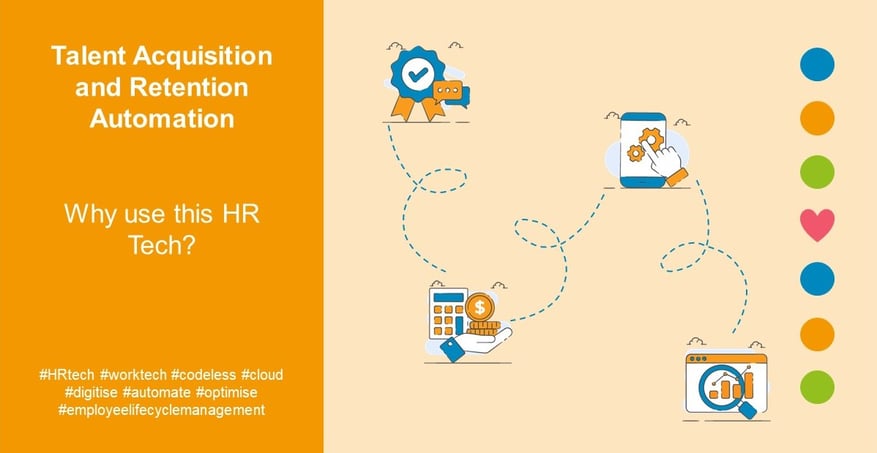In recent years, the human resources space has faced tremendous challenges. Digital transformation at lightning speed, changing workforce demographics, diversity, equity, and inclusion (DEI), evolving employment laws and regulations, remote and flexible work and so much more.
All these changes have ushered the industry into a new era of automation and technological intelligence that would have been unimaginable even a decade before.
But in this new world, it is now becoming increasingly apparent that attracting and retaining top talent is difficult.
Organisations across the globe are aggressively competing for skilled professionals, especially in emerging fields like technology and data science. Retention is also a minefield, as employees are more willing to explore new opportunities and switch jobs frequently.
So how can you navigate the murky waters of talent acquisition and retention in 2023?
Read on to find out how HR automation may very well be the best answer to acquisition and retention challenges ⬇️

Understanding Talent Acquisition and Retention Automation
Talent acquisition automation refers to the use of technology and automated processes to streamline and optimise various stages of the recruitment and hiring process. It involves leveraging tools, software, and platforms to automate repetitive tasks, improve efficiency, and enhance the overall recruitment experience for both candidates and hiring teams.
There are many different activities that can be encompassed by talent acquisition and retention automation:
-
Sourcing automation
-
Application tracking system (ATS)
-
Pre-employment assessments
-
Video interviewing
-
Candidate relationship management (CRM)
-
Onboarding automation
-
Employee engagement surveys
-
Performance management systems
-
Learning management systems (LMS)
-
Employee feedback and recognition
-
Career development tools
-
Workforce analytics
-
Succession planning
-
Stay interviews and predictive analytics
Talent acquisition and retention automation is revolutionising the HR space. The benefits are huge – enhancing efficiency, candidate experience, data-driven decision-making…
Along with the many benefits, leveraging these HR automation tools also means staying competitive in the talent market. This forward-thinking approach empowers HR professionals to focus on strategic initiatives, build robust talent pipelines, and nurture a strong employer brand.
With the power of HR automation, organisations are able to streamline their talent acquisition and retention efforts, ensuring they attract and retain the best-fit candidates to drive their success. ✅
Why You Should Implement Talent Acquisition Automation: Core Benefits

In today's competitive job market, organisations face the challenge of attracting and securing top talent efficiently.
Talent acquisition automation offers a solution that brings numerous benefits to the hiring process – let’s explore 👇
Improved Candidate Experience
Today’s typical candidate expects a seamless and transparent hiring process. That’s why it’s particularly interesting that implementing talent acquisition automation significantly enhances the candidate experience.
A seamless experience for candidates
With talent acquisition automation, organisations can provide a seamless and transparent hiring process that keeps candidates engaged and informed.
HR automation tools enable timely updates on application status, interview scheduling, and feedback. This level of engagement and transparency leaves a lasting impression, boosting the organisation's reputation and attracting the best candidates.
Enhanced communication and engagement
At the same time, effective communication and engagement are vital throughout the hiring process. Manual processes often lead to delays and inconsistencies in communication, causing frustration for candidates. Talent acquisition automation eliminates these challenges by enabling efficient and consistent communication.
➡️ Automated tools facilitate personalised messages, emails, and content tailored to each candidate's profile and stage in the hiring process. This personalised approach fosters better engagement, increasing candidates' interest in the organisation and the position.
Personalised candidate interactions
HR automation also allows organisations to deliver personalised interactions at scale, creating a tailored candidate experience. Automated emails, messages, and content provide candidates with a unique and meaningful experience, making them feel valued and appreciated. This personalised touch builds stronger relationships and sets the stage for successful talent acquisition transformation. 👍
Reducing recruitment delays and bottlenecks
Delays and bottlenecks can hinder the hiring process, leading to missed opportunities and losing top talent to competitors. Talent acquisition and recruitment automation mitigates these challenges by streamlining workflows and eliminating manual tasks.
Automated resume screening and candidate assessments significantly reduce administrative burdens, saving time and ensuring a more efficient selection process. Furthermore, HR automation tools facilitate interview scheduling, minimising communication gaps and delays.
Enhanced Quality of Hire
When it comes to talent acquisition, organisations are constantly seeking ways to improve the quality of their hires. Talent acquisition automation provides a powerful solution by leveraging data-driven insights as well as promoting consistency and objectivity throughout the hiring process.
Better candidate assessment and selection
Talent acquisition automation enables HR professionals to make more informed decisions through data-driven insights. Automation tools collect and analyse data from various stages of the recruitment process, including the steps of resume screening, assessments, and interview evaluations.
This data-driven approach increases the likelihood of hiring candidates who possess the skills, experience, and cultural fit necessary for success in the organisation. The insights gathered also allow HR to identify patterns, assess candidate suitability more accurately, and make evidence-based selection decisions. 🔍
Consistent evaluation criteria and objective decision-making
HR automation ensures that evaluation criteria remain consistent throughout the hiring process. Automated tools facilitate the creation of scoring rubrics, competency frameworks, and assessment models that perfectly align with organisational goals and values.
This standardised approach helps HR professionals compare candidates fairly, ensuring that the evaluation process is based on objective measures.
Reduction of bias in the hiring process
We all know how easy it is for unconscious biases to inadvertently influence hiring decisions. Talent acquisition automation minimises bias by introducing standardised processes and removing subjective factors.
Automated tools enable recruiters to create structured interview templates, ensuring that all candidates are asked the same set of relevant questions. This eliminates potential bias arising from varying interview approaches.
Additionally, automated resume screening and assessment tools focus on qualifications and skills, reducing the impact of bias related to personal characteristics. 🧑

Cost Savings and ROI
Talent acquisition is not only about finding the right candidates but also about managing recruitment costs effectively. It offers a solution that not only enhances the efficiency of the hiring process but also delivers substantial cost savings for organisations.
Reducing recruitment costs
Talent acquisition automation significantly reduces recruitment costs by streamlining sourcing and screening processes. Automated tools enable organisations to leverage multiple channels, such as job boards and social media platforms, to source candidates without relying heavily on costly external agencies. This eliminates the need for manual resume screening, saving valuable time and resources.
Less manual errors
Manual errors in the recruitment process can lead to costly consequences, ranging from poor candidate assessments to inefficiencies in decision-making. Talent acquisition automation mitigates these risks by eliminating manual errors. With automation tools, data entry becomes accurate, evaluation criteria standardised, and objective insights a driving force for decision-making.
Less turnover costs
Vacant positions are often detrimental to organisations, resulting in decreased productivity and increased workloads for existing employees. Talent acquisition automation plays a key role in improving time-to-fill by expediting the recruitment process.
Automated tools facilitate faster sourcing, screening, and evaluation, enabling organisations to identify and secure qualified candidates more swiftly.
Moreover, talent acquisition automation improves the quality of hire, leading to reduced turnover costs associated with hiring replacements and retaining new employees.
Scalability and Flexibility
Talent acquisition automation empowers organisations to handle high applicant volumes efficiently, adapt to evolving hiring needs, and provide scalable solutions for businesses of all sizes and industries. ⬇️
Ability to handle large volumes of applicants
As organisations grow and job openings attract a larger pool of candidates, managing applicant volumes becomes increasingly challenging.
Talent acquisition automation streamlines this process by automating sourcing, screening, and evaluation. Automation tools enable recruiters to efficiently sift through large volumes of resumes, identify top candidates, and eliminate unqualified applicants.
Adaptability to evolving hiring needs and changing business requirements
Business requirements and hiring needs can change rapidly, necessitating flexibility in talent acquisition strategies. Talent acquisition automation provides the adaptability organisations require to keep pace with these changes.
Automation tools offer customisable workflows and configurable features, enabling organisations to tailor their recruitment processes to align with evolving needs. Whether it's adjusting evaluation criteria, modifying job posting strategies, or integrating new assessment methods, automation facilitates seamless adaptation to changing hiring requirements.
Scalable solutions for organisations of all sizes and industries
Talent acquisition automation solutions are designed to accommodate organisations of all sizes and industries. From small startups to multinational corporations, automation tools offer scalability that aligns with an organisation's growth trajectory.
Automation tools provide customisable features, allowing organisations to scale their talent acquisition processes as their hiring needs expand. They allow HR teams to handle recruitment for a few select positions or manage huge hiring volumes, providing the necessary flexibility to support the hiring demands of diverse organisations.
The Key Features and Tools of Talent Acquisition Automation
Talent acquisition automation has become essential for organisations seeking to optimise their recruitment processes. With a range of tools and features available, automation simplifies and enhances talent acquisition workflows. 👇

Applicant Tracking System (ATS)
At the core of talent acquisition automation lies the Applicant Tracking System (ATS). This software provides a centralised platform for managing the end-to-end recruitment process.
An ATS enables job posting, resume management, candidate tracking, and collaboration among hiring teams. It streamlines workflows, automates email communications, and facilitates interview scheduling, ensuring a seamless and organised hiring experience.
AI-powered Candidate Sourcing
AI-powered candidate sourcing tools leverage advanced algorithms to search for potential candidates across various channels. These tools can scan job boards, social media platforms, and professional networks to identify candidates who match specific criteria.
AI algorithms analyse keywords, experience, and other factors to provide a curated list of relevant candidates, enabling recruiters to find qualified talent more efficiently.
Interview Scheduling and Automated Communication
Automation tools offer features for interview scheduling and automated communication. These tools eliminate the back-and-forth communication between recruiters and candidates by providing self-scheduling options based on availability.
Automated communication capabilities allow recruiters to send personalised interview invitations, reminders, and updates to candidates, enhancing the candidate experience and streamlining the interview process.
Candidate Relationship Management (CRM)
Candidate Relationship Management (CRM) systems automate candidate engagement and nurture relationships. CRM tools enable recruiters to store and manage candidate data, track interactions, and send targeted communication.
This essentially means that recruiters can maintain a pipeline of potential candidates, nurture relationships over time, and ensure timely and personalised communication throughout the hiring process.
Reporting and Analytics
Reporting and analytics tools provide valuable insights into the recruitment process. These tools capture and analyse data, offering metrics and visualisations that help assess the effectiveness of recruitment strategies.
Recruiters can track key performance indicators (KPIs) such as time-to-fill, cost-per-hire, and source of hire. These insights inform data-driven decision-making, identify areas for improvement, and optimise recruitment efforts.
Best Practices for Implementing Talent Acquisition Automation

Implementing talent acquisition automation can transform your recruitment processes, improving efficiency, and enhancing hiring outcomes. However, successful implementation requires careful planning and consideration. 👇
Assessing organisational needs and goals
Before implementing talent acquisition automation, assess your organisation's unique needs and goals. Identify pain points and areas that would benefit from automation. Consider factors such as the volume of hires, recruitment complexity, and desired outcomes. Understanding your specific requirements will help you select the right automation tools and tailor the implementation process accordingly.
Selecting the right talent acquisition automation tools and vendors
Choosing the right tools and vendors is crucial for a successful implementation. Evaluate available automation solutions based on their features, scalability, ease of use, and integration capabilities.
Consider the vendor's reputation, customer support, and compatibility with your existing HR systems. Engage in thorough research, read reviews, and, if possible, request demos or trials to ensure the selected tools align with your organisation's requirements.
Ensuring seamless integration with existing HR systems
To maximise the benefits of talent acquisition automation, ensure seamless integration with your existing HR systems. Evaluate the compatibility of the automation tools with your applicant tracking system (ATS), HRIS, or other relevant systems. Integration allows for data sharing, reduces duplicate entries, and enhances the overall efficiency of your HR processes.
Training and upskilling HR teams for effective utilisation
Provide comprehensive training and upskilling to your HR teams to ensure they can effectively utilise the talent acquisition automation tools. Train them on the features, functionalities, and best practices of the automation tools. Encourage adoption and address any concerns or resistance by highlighting the benefits and demonstrating how automation streamlines their workflows and enhances their capabilities. Ongoing training and support will ensure that your HR teams can fully leverage the automation tools to achieve optimal results.
Monitoring and evaluating the automation process for continuous improvement
Implementing talent acquisition automation is not a one-time event; it requires continuous monitoring and evaluation. Establish key performance indicators (KPIs) to measure the impact of automation on recruitment metrics, such as time-to-fill, quality of hire, and cost-per-hire.
Regularly assess the effectiveness of the automation process and identify areas for improvement. Solicit feedback from HR teams, hiring managers, and candidates to gain insights into the user experience and identify opportunities for refinement.
Talent Acquisition and Retention Automation is The Future

In this blog post, we have explored the transformative power of talent acquisition and retention automation. These technologies have revolutionised sourcing, screening, and decision-making, leading to increased efficiency and improved candidate experiences.
The impact of emerging technologies on talent acquisition has been significant. Automation tools have optimised communication, reduced bias, and enhanced the overall efficiency of the hiring process. These advancements have resulted in much higher-quality hires and an improved candidate experience.
Looking ahead, the future of talent acquisition automation is promising. We predict an increased focus on personalised candidate experiences, leveraging AI algorithms to tailor interactions and recommendations. Automation tools will provide even more data-driven insights, enabling augmented decision-making and accurate forecasting of candidate success. The use of VR technology for skill assessments and the integration of chatbots and virtual assistants will further enhance the efficiency and effectiveness of talent acquisition automation.
Embracing the future of talent acquisition automation will enable you to streamline your recruitment processes, improve the quality of your hires, and create exceptional candidate experiences. 👍
✅ Want to explore more valuable HR strategies? Check out our whitepaper on storytelling for HR – discover how storytelling can transform your HR strategies and unlock the full potential of your workforce!

